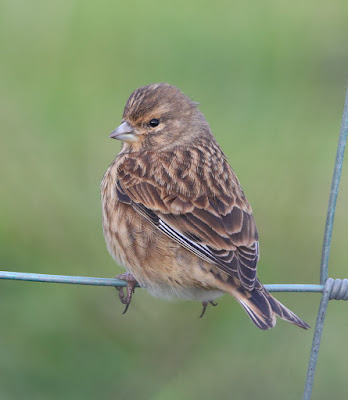After one of the few overnight frosts of the winter Sunday began with a layer of ice. I set off with a couple of tail slides and the dash showing 0°C.
The raised road over Stalmine Moss catches any overnight ice and frost and where one false move over the roller coaster road can see a vehicle plunge into one of the roadside ditches that lie either side. There must have been a layer of ice in the ditches because three Little Egrets stood around on the roadway wondering where their open water feeding had gone. The nearby flash flood had a film of ice with now a small patch of open water with just 20 Lapwings and a single Black-headed Gull.
Little Egret - Stalmine Moss
At the junction of Lancaster Road was another Kestrel, the third of my so far short journey and all of them sat atop roadside posts watching and waiting for movement on the whitened ground below. Later, and by midday the morning proved to be good for Kestrels with at least six observed throughout the four hours.
Kestrel
I drove towards Cockerham and Wimarleigh where I checked out the latest ringing/birding site where the owners have given permission for both ringing group members and their vehicles to access their private land. Very soon we hope in return to give the owners lots by way of birding/ringing data together with an understanding of the bird species that use their land throughout the year. This should keep us busy, enhance the land owners’ existing environmental policies and help towards their future plans.
There was a lively start when I heard Fieldfares close by and then through a handy gateway spotted what appeared to be a dozen or two amongst a flock of Starlings. In fact as I settled down to watch, the numbers feeding in the undulating field seemed closer to 250 Starlings, 250 Fieldfares and 15/20 Redwings. Once or twice the whole lot took to the air when both a Sparrowhawk and then a Buzzard came by. These birds may be new arrivals from the near Continent as both Redwings and Fieldfares have been rather hard to come by around here throughout December. But with no berries left the hedgerows open fields and treetops are the best places to find the shysters with their bills now darkened by soil rather than berry juice.
Redwing
Fieldfare
Along nearby woodland edge was a large mixed flock of titmice, 50 or more strong with a large contingent of both Long-tailed Tits and Blue Tit but not so many of Great Tit and Coal Tit. It has been a mild winter where survival of this bird family has been for me at least, undocumented until now.
Long-tailed Tit
Also along the woodland edge, 8/10 Blackbirds and a solitary but welcome Song Thrush. I checked out a marshy pond, a reedy ditch and a meagre looking but newly planted hedgerow. 30+ Mallards, 1 Reed Bunting, 1 Kestrel, 1 Grey Heron, 1 Buzzard and countless Starlings were to be expected but perhaps not the single Stonechat which worked the fence line and the ditch where it seemed to find food-a-plenty.
In the distance and closer to Winmarleigh I could see hundreds of Pink-footed Geese feeding in extensive pastures with not a road in sight. Those geese are expert at finding quiet fields in which to feed in between avoiding the morning and evening gun rush.
I called at Gulf Lane where Linnets numbered 150+ and still feeding on the natural stuff close to the fence - unlike the 8 Stock Doves that lifted from the line of rape/millet seed I dropped two days ago.
Linnets
Linnets
I waved goodbye to the ungrateful Linnets but warned them we’d be back soon - with nets.
Linking today to Stewart's World Bird Wednesday.



































































.jpg)













